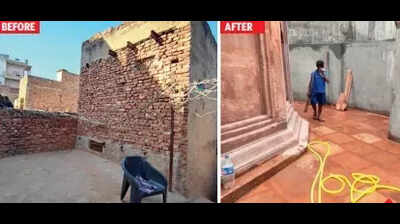ARTICLE AD BOX

NEW DELHI: On the Delhi state archaeology department's agenda is the restoration of four historic sites in the city - the Dwarka baoli, the kos minars near Indraprastha Apollo Hospitals and at Badarpur border and a minar in Hastsal village.
While work on the Dwarka stepwell and the milestone at Badarpur border have been completed, the process is nearing completion at the other two sites. The estimated cost of these projects was over Rs 30 lakh.The baoli at Dwarka, also known as Loharheri ki Baoli, is a 16th-century stepwell built in the Lodhi era to serve the ironsmith community of Loharheri village. Hidden for years under vegetation, it was rediscovered and is now recognised as an important architectural site.
Located between a school and residential complex in Sector 12, the restored structure now features repaired stone flooring, lime replastering and repainted grilles and gates.

The kos minar on Mathura Road close to Badarpur metro station is a Mughal-era milestone that once marked distances along imperial travel routes. These minars played a crucial role in communication and navigation during the Mughal period.
Restoration work at the site included repairs to the rubble masonry boundary wall, stone paving, repointing and repainting of grilles.Work at the kos minar near Apollo Hospital is in its final stages and is likely to be completed at the end of this month. According to INTACH, the minar is a cylindrical, tapering structure with three horizontal moulded sections, an octagonal base and a domed top. Once used to mark distances - one kos equals approximately 3km - these structures were part of India's medieval road system.
Restoration includes building a brick boundary wall, stone flooring, masonry reinforcement, chemical cleaning and installation of new grilles and a gate.In Hastsal village, restoration is under way on a 17-metre-high, three-storeyed brick minar built during emperor Shah Jahan's reign. Likely intended as a shooting tower near the Mughal emperor's hunting lodge, the minar features red sandstone facades, a narrow internal staircase and architectural elements reminiscent of Qutub Minar.
Ongoing work includes boundary wall construction, lime plastering, red sandstone flooring and painting of grilles and walls.
Completion is expected by Aug-end.In addition to these projects, the Delhi Tourism and Transport Development Corporation is overseeing the restoration of several other monuments and improve public access to them. These include six monuments within Mehrauli Archaeological Park, three in Lodhi Garden, as well as Ghost Gumbad, Baradari Qudsia, the Tomb of Bijri Khan, Mutiny Memorial, Turkmen Gate and Bawana Jail.
Plans include adding amenities like restrooms and lighting wherever space allows.Department officials said that while some sites like Quli Khan's Tomb in Mehrauli Archaeological Park and Shah Jahan's Turkman Gate will undergo structural stabilisation and restoration, others were being given visitor-friendly features. The Mughal-era tomb of Paik, located near Mukarba Chowk, is getting a complete makeover. An amphitheatre and cafeteria are under construction, along with an interpretation room to help visitors understand the monument's historical significance and boost tourist engagement.



.png)
.png)
.png)
















 4 hours ago
6
4 hours ago
6









 English (US) ·
English (US) ·